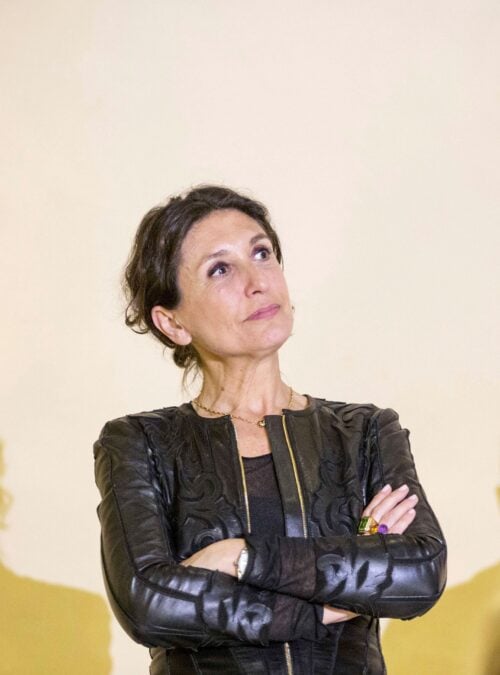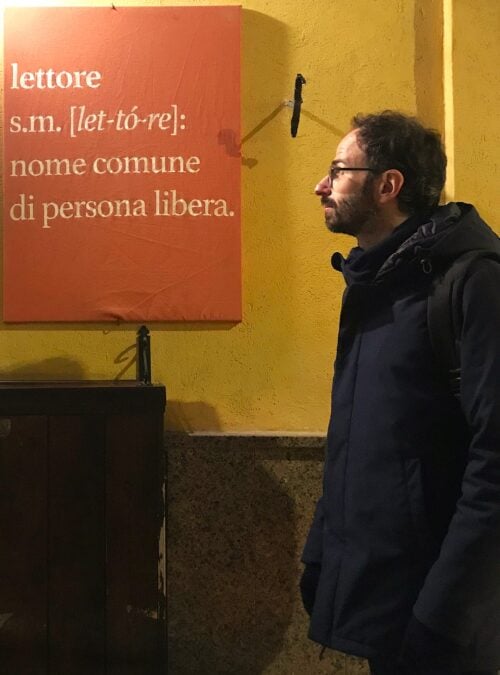Interview with Bompiani editors
Author: Laura Pugno

Bompiani is one of the historical brands of Italian publishing. It has been many years since its founder Valentino Bompiani left the reins of the family business, but the memory of his lesson is still alive in the publishing house, as attested by the statements of its editors Beatrice Masini (editorial director), Giulia Ichino (Italian fiction and non fiction editor), Silvia Trabattoni (non fiction editor), Andrea Tramontana (paperback and catalogue editor), interviewed by Laura Pugno.
How would you describe Bompiani’s Italian fiction and nonfiction to readers abroad? What are its characteristics and strengths?
Giulia Ichino.
Both Bompiani’s fiction and nonfiction are first and foremost characterised by a strong emphasis on authorship: ours wants to be a house for authors who have a distinct voice, in terms of their choice of themes as well as writing style. Sometimes this creates singular short-circuits between the books we publish, well beyond our intention or forecasting ability: to give just one example, a few months ago we published the third volume of Antonio Scurati’s monumental work on Fascism, set between 1938 and 1940, and the little-known story of Commander Salvatore Todaro’s extraordinary acts of courage in the Atlantic Ocean, narrated in Sandro Veronesi and Edoardo De Angelis’s novel, of which we have just received the first copies. Then we have a moving novel coming out in February, in which Igiaba Scego retraces the history of her family, with its chronological starting point precisely in the years of the Italian occupation of Somalia, and provides a depiction of the figure of her grandfather, an interpreter for General Graziani. Fascism and its horrors are also at the centre of some of Francesca Melandri‘s novels, which we have recently welcomed into our catalogue with joy. And so, thinking of this line of ‘narrative reinterpretation’ of our history, we can’t fail to mention Giulia Caminito‘s novels, Marta Barone‘s Sunken City; Lidia Ravera, and the staunch activism of Roberto Saviano, who also works with us in curating the Munizioni series. We could go on and on. Here: this is really only one of the examples of underground currents that link all the books we publish, creating a chorus of voices, each as unique than ever, yet all together forming a discourse.
Another important aspect of Bompiani’s tradition is linked to the cultural legacy of Umberto Eco and his openness to linguistic play, to the contamination of ancient and modern. This is why we also happily publish genre novels, and even dedicate a series to the field invented by Eco himself, that of the ‘light-hearted Hamleticism’, which explores the territories of comedy, riddles, and satire.
One of the trends we are witnessing, is a growing blurring in the once clear boundary between fiction and nonfiction. With the specific objective of finding space for works that frame relevant themes but do so at a narrative pace, we have been working in recent weeks on a new way to organise or classify our non-fiction series.
Silvia Trabattoni
Bompiani’s nonfiction publications is a combination of several complementary facets: it includes solid non-fiction, featuring experts who know how to discuss the most disparate topics with the simplicity afforded by their knowledge, and who are able to combine accurate research and information with the pleasure of reading. This is the type of nonfiction that is curious about the present and its dynamics, that aims at serving as a compass to move through the complexity of our time, committed in its intention to spark conversations within the realm of public debate and give it a lively boost – a sort of renewed bond with that first and original vocation that pushed Valentino’s Bompiani to be a publisher of nonfiction focusing on current affairs, with ‘Books selected to serve the landscape of our time’. Alongside essays – covering popularisation of technical topics, current-affairs, cultural criticism – there is also room for the many forms of narrative nonfiction, books that are different in nature and purpose, but all share a distinctive trait: they tell stories, often unique and singular stories that shed light on a larger story; they each do so in their own way, drawing as much from lived reality as from the power of narration. This range means that we are able to reach readers who have different needs, interests, and tastes, but who can all identify with a community that enjoys discovering strong and unexpected voices.
Andrea Tramontana
One of Bompiani’s strengths is its catalogue, meaning the set of literary works (mainly fiction but not only) that are part of the history of the brand founded by Valentino Bompiani in 1929. He was at the helm of the publishing house until 1972, and made a mark that was destined to last: by selecting and editing books conceived for the present, to ‘give the landscape of our time’, Bompiani’s backlist is as heterogeneous as ever and full of titles with a central history both in terms of literary awards as well as success in terms of readership. In his autobiography, Il mestiere dell’editore, Bompiani writes: ‘The economic value of a publisher cannot disregard cultural value. Bestsellers pass, real writers last. The English say: ‘Choose a friend ten years before the day he can serve you’. This is the abc of publishing. The books chosen ten years before their success are the ones that will form a publishing house’s catalogue and true legacy.”
Our catalogue today presents the sedimentation of different eras and tastes, but it stands out for its mission to discover titles that go beyond their time, their paper life-cycle, and beyond the national territory. One name among many is Alberto Moravia: numerous films have been made from his novels, including Vittorio De Sica’s Two Women, Jean-Luc Godard’s Contempt, Bernardo Bertolucci’s The Conformist and more recently in 2020 – demonstrating how Moravia continues to be an inspiration even for young directors – Leonardo Guerra Seràgnoli’s The Time of Indifference. To date, Alberto Moravia’s works continue to be bought, published, and read in more than thirty countries around the world, from as close as France, Spain, and Germany to as far as China, Brazil, and Vietnam.
But this is not the only case. A constant tendency of the last decade, intensified after 2020, is to search through the production of past decades for books that have been forgotten by readers over time, perhaps no longer published despite the very high value and quality of writing. There is often talk of republishing operations, and they are sometimes very successful, because the moment a publisher republishes these lost and rediscovered treasures, the value of the work is there, waiting for readers, intact and as bright as if they had been written today.
Bompiani’s catalogue – in particular the “Classici contemporanei” series, which largely collects foreign and Italian longsellers, books classified as “modern classics” – offers a wide range of titles that historically belong to the publishing house, such as The Plague Sower by Gesualdo Bufalino Conversations in Sicily by Elio Vittorini, or a few notable XX century books such as Ninfa plebea by Domenico Rea and The Fifth Gospel by Mario Pomilio featuring a new presentation. This is the pool of greatest interest for publishers involved in rediscovering and recovering twentieth-century novels. Two cases of international success for novels from the last century include Marina Jarre and Gianfranco Calligarich. Jarre is a writer who died in 2026 and published most of her books from the 1970s to the early 2000s. Distant Fathers was published in 1987 and had become unavailable for some years. When in 2021 Bompiani started to recover a group of her titles, with accompanying texts by a young and sensitive writer, Marta Barone, charged by Marina Jarre’s heirs with the task of finding a home for her entire body of work, publishers and readers abroad were able to discover a voice that was missing from the Italian scene, so today her work has been translated or is in the process of being translated in seven countries. The second novel dates back to much earlier, but was written a living author: Calligarich‘s Last Summer in the City is his 1973 debut novel, discovered and treasured by Natalia Ginzburg, and long disappeared from bookshops. This book was recently re-published in a new edition by Bompiani, and it has quickly and exponentially become a true cult novel, has been translated into twenty-two languages, and managed to win over even the sophisticated readers of the French publisher Gallimard, and to receive praise from writers such as André Aciman. These cases demonstrate how readers in general appreciate quality writing and books regardless of the year of their publication, and how for all those texts that are neither canonised classics nor publishing novelties, there is a space and an opportunity for visibility.
Which bets, literary and otherwise, have worked best in foreign countries and in your opinion, why?
Beatrice Masini
With regard to fiction, our commitment is to export beyond the national borders novels that are rich in character, including from a formal point of view; books that tell the story of Italy in its past and present (and perhaps also in the future) without indulging in picturesque stereotypes, though much sought after by publishers of other languages, who, at trade fairs, confusingly ask for “something Italian but not too much” (this is not true for all them, obviously, but it is true for many). To an American or British reader, on the other hand, any Italian story can risk to be seen as a provincial, vaguely exotic story; however, in buying books from abroad, we don’t make an issue of the fact that we are not familiar with the realities they tell; rather, we have always been very curious about new voices that tell of places and universes we know little about. In this I find that there is still a certain level of disparity. However, the foreign success obtained by novels rooted in our geographical, historical, and cultural territory confirms a simple truth, and namely the fact that stories and the form they take do count and do win. This is even more true for books for children and young readers, where the authors’ creative freedom is matched by the publishers’ freedom to take-in and adopt non-canonical books.
Giulia Ichino
Many of our books have been translated abroad, and this makes us very proud: when unique and strongly recognisable voices are published, their strength transcends national borders.
Silvia Trabattoni
From illustrated books to non-fiction signed by great catalogue authors such as Moravia, the books that find success abroad are many and heterogeneous. In recent times, those books which have roused a certain amount of interest have been those that are able to brilliantly tackle themes where contemporary life is questioned, and which are felt as necessary reflections to better understand and inhabit our time.
Milan, January 2023










